Otello
Verdi didn’t want to compose anymore…
If you’ve read our article about Aida, you should know how reluctant Verdi was to write anything anymore. By that time, he thought he had done his share of composing. His almost 30 titles, which mostly had been successes, had made him famous. And they had made him rich.
After the new Italian nation, formed in the 1860s, Verdi tried politics. In 1874 he became a Senator for life, without spending much time in Rome though. Remember, he hated traveling. He was very busy building his estate, Sant’Agata, he conducted and supervised his compositions and he composed Messa di Requiem in 1874.
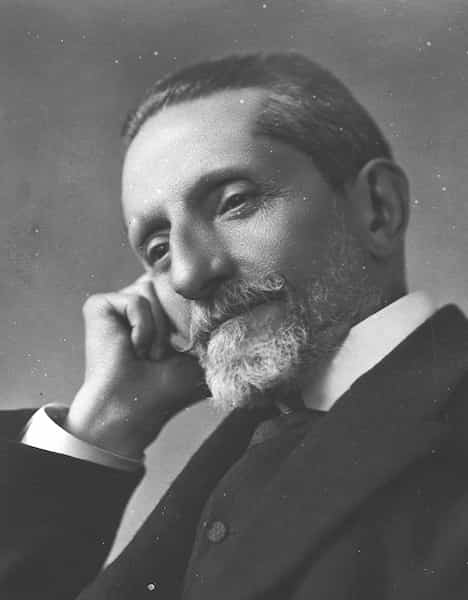
But after all, he considered himself retired. He felt old, and he didn’t have the artistic drive anymore. His friend and publisher, Giulio Ricordi, didn’t agree though. But Ricordi also realized that it would take a lot of persuasion to convince the Maestro to pick up the pen again. He went so far as to have the whole orchestra of La Scala play outside the composer’s hotel suite. All to make Verdi feel appreciated.
The cunning plan by Ricordi and Faccio.
Finally, in 1879, at a dinner party, Giulio Ricordi and the conductor Franco Faccio were talking casually with Verdi. But it wasn’t an innocent small talk. They both had worked out a plan. They should speak about music, lead the conversation into new tendencies, over subjects that younger composers chose, and continue on to writers. From there they should bring the discussion to Sheakspear, which they both knew Verdi liked very much.
The trick worked, and when they reached that point in the discussion, and they could introduce Othello as a suitable text, Verdi’s curiosity was awakened.
Arrigo Boito was chosen to write the libretto. But Verdi couldn’t be pushed, not even guided. They all had to nourish the feeble flame of inspiration with caution. So, Boito practically wrote the text and sent it page by page to the composer just hoping that he would write something. And this slow process took 7 years. But in November 1886 Otello was completed.
Premiere – February 5, 1887, Teatro alla Scala, Milan, Italy
Composer – Giuseppe Verdi
Librettist – Arrigo Boito
Running Time – Approximately 2 hours and 20 minutes plus intervals.
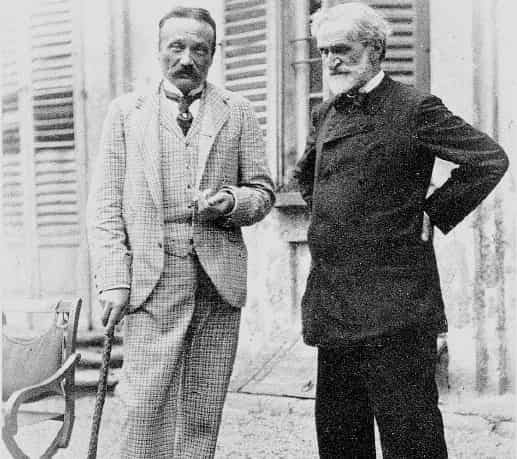
Four Acts
- There’s no Overture.
- First Act: ca 30 minutes
- Second Act: ca 35 minutes
- Third Act: ca 40 minutes
- Fourth Act: 35 minutes
In Italian
Main characters:
Otello: Dramatic Tenor. General of the Venetian Armed Forces. Moor.
Desdemona: Lyric-Dramatic Soprano (… or possibly Lyric). His wife.
Jago: Dramatic Barytone. Otello’s Ensign.
Cassio: Lyric tenor. Captain
Roderigo: Tenor. Young Venetian gentleman.
Emilia: Mezzo-soprano. Jago’s wife and Desdemona’s maid.
Lodovico: Bass, Ambassador of the Republic of Venice.
Download this short Pdf-guide. Print it, fold it, and keep it in your pocket as a help when you’re at the Opera. Please keep your phone turned off when inside the theater.
Background – The Opera Otello is set in…
Cyprus
The Venetian Republic dominated the eastern Mediterranean for hundreds of years. But when the Ottomans started their empire-building in the 15th century, Venice had a hard time resisting them. For centuries, these two great military powers struggled, but at the end of the 16th century, the Turks had the upper hand. Cyprus was heavily defended by the Venetians as it was strategically extremely important. It was the last Venetian outpost towards the east where all the profitable trading was going on.
The Republic of Venice lost Cyprus to the Turks in 1571, and never took it back. Otello is set in the years leading up to that surrender.
Otello is the general, and Governor of the Island. He’s second to very few people in Venice. We begin the opera right after a tremendously fierce battle between the Venetian and the Ottoman fleets. Losing the battle would mean the end of the Venetian Cyprus, and probably the end of every living Venetian soul on the island. But in the distance, we see Otello’s ship with sails and the Republican flag raised.
A problem for Otello is that he is a moor… He is black. And that makes him a target for envy, and racism. And there’s one person close to him who hates him beyond reason…
Would you like to visit Cyprus?
Would you like to see the sites where the Opera takes place?
Plot
First Act – A coastal town somewhere on Cyprus (… read Famagusta).
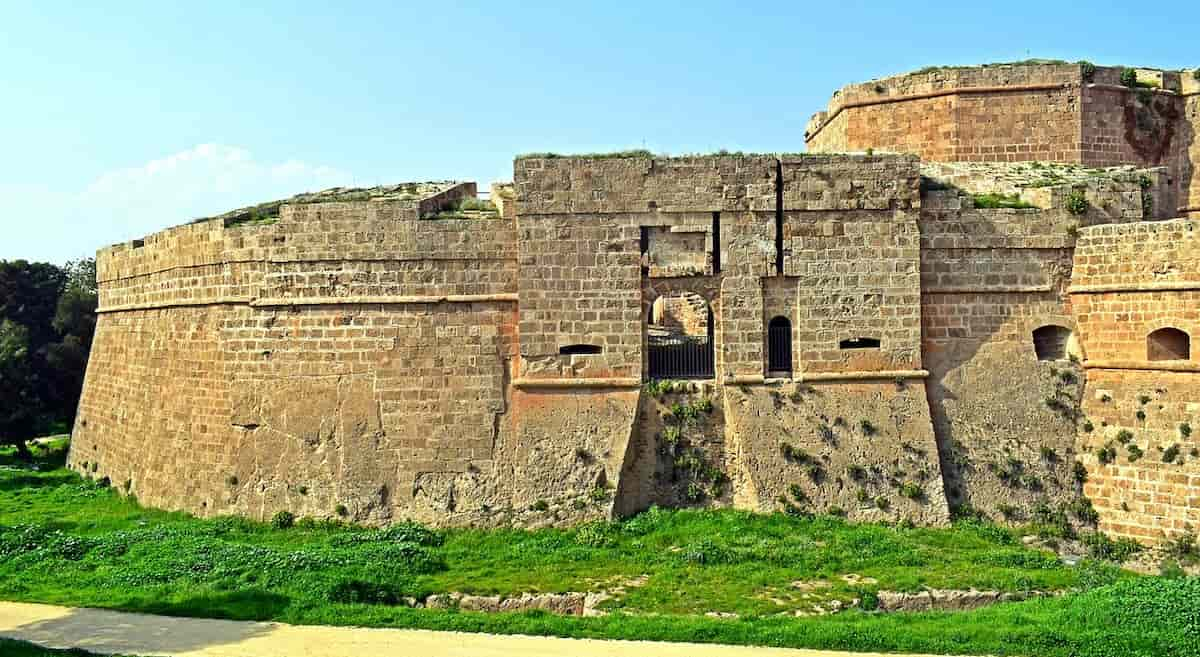
Immediately, there’s the famous storm scene. We see the crowds running back and forth waiting for the returning Venetian ships. The chorus sings:
– Una vela… (A sail…)
Through the gale, the ships return to the port. Otello is back alive and well and the city is saved. Now there’s one of the most mythical and famous entrances of any character in any opera. Otello arrives and sings:
– Esultate! L’orgoglio musulmano sepolto è in mar. (Rejoice! The Muslim pride is buried in the deep.)
The Chorus sings one of many brilliantly composed passages. This is a wonderful opera for the Chorus…
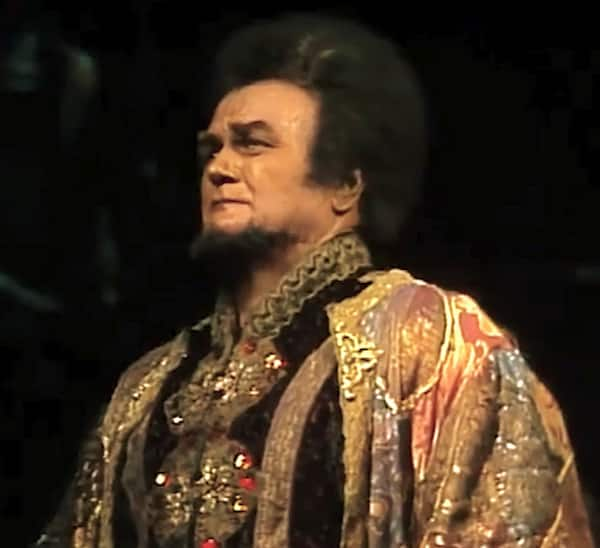
– Vittoria… Sterminio… (Victory… Destruction…)
Now, Jago and Roderigo talk. In Jago’s words, we immediately understand that:
- Jago hates Otello. One reason is that the General promoted Cassio to Captain when Jago thought it should have been him… And he calls Otello “the thick-lipped savage”.
- Roderigo is taken by the beauty of Desdemona, Otello’s wife. He knows that he can’t do anything about that, but Jago encourages him and even offers to help.
And now comes another highlight for the Chorus:
– Fuoco di gioia… (Fire of rejoicing! The jovial flame… The fire of love fades quickly…)
Now it’s time for celebration, and to get drunk. Jago and the Chorus sing:
– Chi all’esca ha morso del ditirambo…
… But during the heavy partying, Jago pushes Cassio to drink more than he should. Then, he provokes the incredibly drunk Captain to draw his sword at Montano, who is a big shot. Actually, Montano is Otello’s predecessor. As they fight, Jago instructs Roderigo to run down to the harbor and shout Revolt! Revolt! When Otello shows up, he is very upset and degrades Cassio from Captain.
The Act finishes with one of the most beautiful love duets ever written. Unusually soft and sweet, for being Verdi. Therefore often very difficult if the two voices, Otello, and Desdemona, are pure dramatic.
– Già nella notte densa…
Second Act – A large chamber overlooking the park.
Jago instructs Cassio to ask Desdemona to help him regain Otello’s trust. Cassio’s wife is Desdemona’s maid, and so he has a natural connection to her. Cassio leaves and Jago sings his famous:
– Credo in un Dio crudel… (I believe in a cruel God who created me in his image… I am wretched because I am a man.)
The introduction is very short. The orchestra plays F-Gb-Bb-C-Ab-Bb-C-F-C-F in unison. And that is almost a Puccini-style line, which shows how mature Verdi is here.
From the Balcony he can see how Cassio approaches Desdemona. And he can see how he talks confidentially with her. To his fortune, at that moment Otello arrives, and Jago can put his scheme into action. The Moor observes Cassio and Desdemona, and with innocent comments, Jago manages to put a small seed of doubt into Otello’s mind.
Here Verdi creates a very effective contrast having everybody enter with flowers in bright colors, while Otello and Jago dwell in the dark.
The chorus praises Desdemona’s beauty and purity. The children’s chorus sings:
– T’offriamo il giglio, soave stel… (We proffer lilies, tender flowers…)
Now Otello, Desdemona, Emilia, and Jago remain. Desdemona pleads for Cassio, but the terrible sickness of jealousy filters her words. The more she insists, the more Otello perceives something completely different. At a certain point, he throws Desdemona’s handkerchief to the ground. Emilia picks it up, but Jago forces her to give it to him. He will need it for the next step in his devilish plan. The women leave.
Otello accuses Jago of having filled his heart with unbearable doubt. Now he asks for evidence. He will not do anything until he has infallible proof. So Jago invents a story about how he heard Cassio speaking about Desdemona in his sleep. And when he tells his general that he saw Desdemona’s handkerchief in the hand of Cassio yesterday, Otello cries out:
– O, I wish he had a thousand lives! One is too poor a prey for my revenge!
And together they sing the terrible duet:
– Sì, pel ciel marmoreo giuro! (… For Death and the exterminator of the dark sea, my vengeance shall rain like thunder!)
Third Act – A great hall.
A herald announces the arrival of the Ambassador from Venice.
Jago tells Otello that he will lure Cassio here and try to make him spill the beans while Otello watches, hidden.
Now there’s a long scene with Otello and Desdemona. By this point, although he’s not certain about her infidelity, he sure treats her with a lot of disrespect. And the handkerchief, that she lost in the second act, plays a huge role. Desdemona is so innocent, that she can’t even grasp what she’s being accused of…
She calls out her desperation in:
– Esterrefatta fisso… (…I hear a fury in your words, but don’t understand them.)
Alone Otello sings:
– Dio! mi potevi scagliar tutti i mali… (God, you could have thrown every evil at me… Mercy, thou immortal rose-lipped cherubin. Let her first confess her crime, then die!)
… And now to the second phase of Jago’s plan. Otello hides, and Jago speaks casually with Cassio. Otello can hear some of what they say, but not everything. Jago knowingly asks Cassio about his mistress, Bianca, and Cassio embroiders on her looks. At a certain point, he pulls out the handkerchief:
– Jago, you know my lodging… By an unknown hand… A fine embroidered handkerchief.
Now Otello is beside himself with rage and jealousy, and on the spot, he decides to kill his wife.
Now Lodovico arrives with a message from Venice. The stage fills up with the Cypriots, honoring their Governor, the Venetian Lion, Otello.
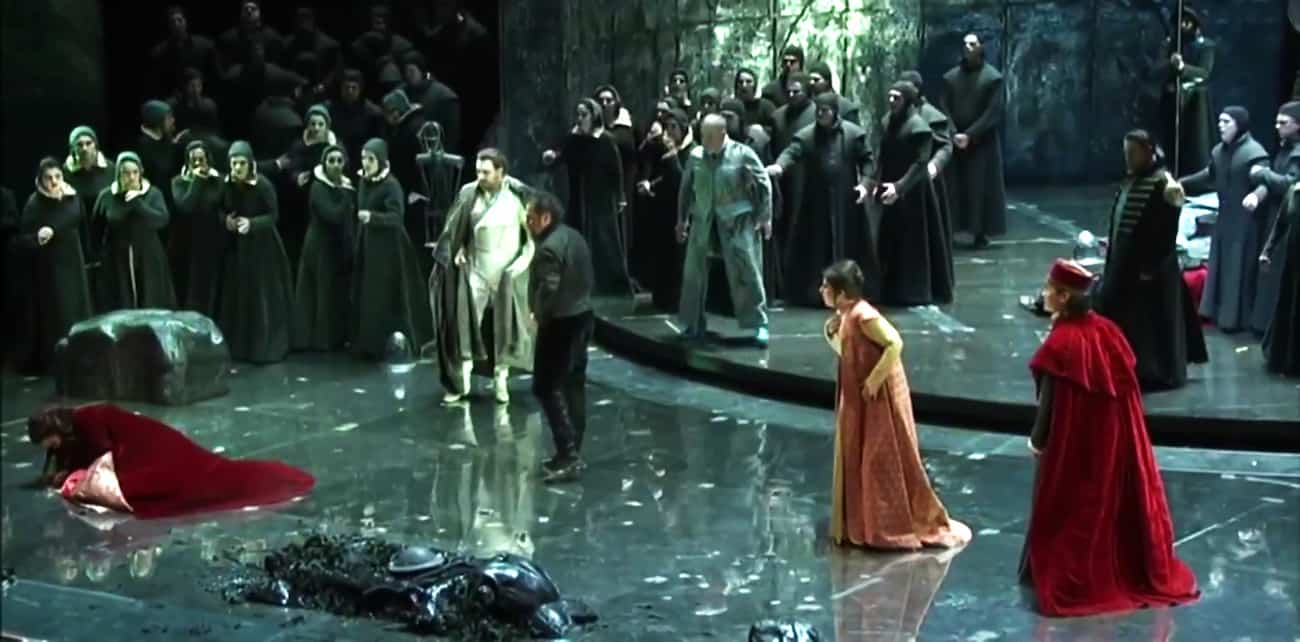
What happens next is rather straightforward. Otello is furious and announces that he has been called back to Venice and that Cassio is to succeed him as governor of Cyprus. In his rage, he behaves like anything but a Venetian Lion. Finally, and in front of everybody, he throws Desdemona to the ground.
Desdemona initiates an ensemble that slowly builds up to include everybody.
– A terra!… sì… nel livido…
During all this, the incredibly cunning Jago manages to do two things:
- Convince Otello that, as he leaves for Venice tomorrow, he must kill Desdemona tonight. Jago himself shall kill Cassio.
- But instead, he convinces Roderigo to do his dirty work for him. He shall assassin Cassio.
When the crowds hail Otello from off-stage, calling him the Lion of Venice, Jago mutters with despise:
– My poison is working… Behold the Lion!
Fourth Act – Desdemona’s bedroom.
Desdemona is completely unaware. She can’t see what has come over Otello, and now she fears for her life. Still, she cannot break free of her love for him. She sings two very famous arias in sequence. First, the Willow song:
– My mother had a maidservant. Her name was Barbara… She loved a man who then abandoned her…
Then the Ave Maria:
– Ave Maria, piena di grazia… (Mary… Show your compassion to the powerful man, who also grieves… Pray for us at the hour of our death…)
The shadow of Otello is seen in the doorway…
________________________________________________________
After the deed, Emilia enters and tells Otello that Roderigo is dead but Cassio lives. When she sees Desdemona’s lifeless body she calls for help. Even in death (Well, she’s obviously not really dead but almost…) Otello’s bride refuses to blame her spouse but instead whispers:
– Nobody is to blame… I did it to myself…
Lodovico, Cassio, and Jago enter, and when Emilia reveals the truth about the handkerchief, Jago flees the scene. Otello stabs himself and to the music from the finale of the first act, he dies next to Desdemona.
Things to look out for.
First Act
- Curtain up – Una vela. The storm scene.
- 4 min – Esultate! Otello entrance.
- 9 min – Fuoco di Gioia. Chorus.
- 17 min – The fight between Cassio and Roderigo begins.
- 22 min – Desdemona’s and Otello’s love duet.
Second Act
- 3 min – Credo in un Dio crudel! Jago’s confession.
- 13 min – Dove guardi splendono… The chorus fills up the stage to honor Desdemona.
- 18 min – Otello throws the handkerchief to the ground, and Emilia picks it up.
- 30 min – Sì, pel ciel marmoreo giuro! Otello’s and Jago’s duet.
Third Act
- 8 min – Esterrefatta fisso.. Desdemona’s short aria.
- 12 min – Dio! mi potevi scagliar tutti i mali… Otello’s aria.
- 28 min – A terra!… e piangi! Otello throws Desdemona to the ground and the big finale begins.
Fourth Act
- 4 min – Mia madre aveva una povera ancella… Desdemona’s Willow Song.
- 12 min – Ave Maria… Desdemona’s prayer.
- 17 min – Otello’s shadow is seen in the doorway…
Esultate! A Tenor’s Nightmare.
The reasons why the first notes to be sung by Otello are so detrimental are three:
- Esultate is written to show off who is in charge… who is the leader, the great hero. It’s supposed to sound truly impressive. And it’s the first thing you sing on stage so you haven’t had any chance to warm up.
- The tessitura (average pitch) is high. There’s a B natural, which is a high note for a dramatic tenor. There is a gradual increase in pitch and volume that can be deceptive.
- You might be a bit nervous. And when you’re nervous, it’s easy to overdo and exaggerate… Simply, to sing too loud.
I have witnessed tenors who, sing Esultate really great, and then go on to do the first act and half of the second well. But arriving at the third act, they have no voice left.
The B can be done in various ways. It is really only an acciaccatura and shouldn’t be focused on. But just the image of it can scare a singer who doesn’t feel comfortable with heights.
So, there are different ways to deal with it…
You can do it the usual way. Sing G# – B – A.
You can do it as it’s written. The B natural as an acciaccatura to the A.
… Or you can simply skip it all together.
Verdi and Wagner
Sometimes the idea of rivalry between these two giants of opera is brought forward. And some say that it was Wagner who made Verdi write Otello. Well, Wagner died in 1883, so he wasn’t there to witness Otello’s premiere. And he wouldn’t have. They never met, and they had no interest in meeting… None of them. But still, Verdi is supposed to have been so provoked by Wagner’s philosophy about the Gesamkuntswerk that he decided to write one of his own.
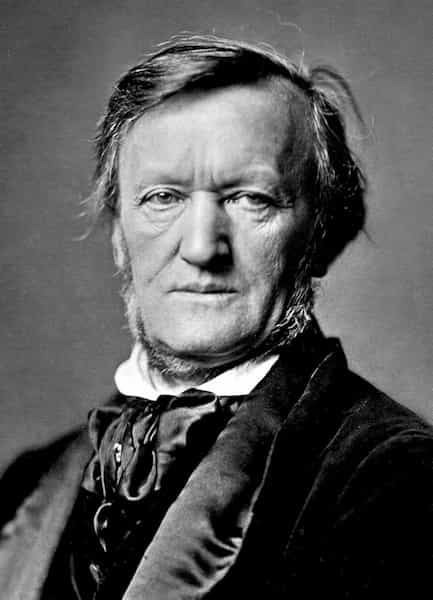
I don’t think it’s fair to put too much emphasis on what Wagner and Verdi thought about each other. They weren’t each other’s fans. But most composers, dead and living, had/have a lot to say about their colleagues… Good and bad.
Wagner and Verdi were two very different persons. They lived very different lives, and they had very different political and musical views. And while Verdi practically all his life was respected, successful, and well-paid, Wagner had to struggle for long periods.
One important thing that Richard Wagner brought to the table though was the through-composed Opera. A single piece of flowing music, not divided into recitatives, arias, duets, and choruses. However, in Wagner’s case, it was usually a very long single piece.
So, finally, Verdi dropped the closed form.
But Wagner didn’t invent the through-composed form from scratch. The idea had grown for decades, centuries even, in the music culture of the major European countries. The “secco” recitatives in opera were long gone, and even Verdi, all the way back when he composed Don Carlos, had adapted a more open, and fluent form.
Still, both Don Carlos and later, Aida have some sort of structure where many of the different numbers have a direction. First, there’s is a slower or more contemplative section, and then something faster or stronger. In Aida, the label recitativo, is still used.
In Otello, Verdi uses a modern construction. There are no borders between the numbers. Everything flows from one scene to another, from one musical reality to another. It is closer to Wagner in that sense.
But by 1880, the times had changed not only in Germany but in Italy too. The musical stage was much freer compared to 1842 when he wrote Nabucco. Three years after Otello, Mascagni’s Cavalleria Rusticana would initiate the new Verismo style. And in 1896, only 9 years after Otello, operas like Puccini’s La Bohème and Giordano’s Andrea Chenier would change the musical language in opera forever.
Otello was Verdi’s contribution to a new musical world.
Download this short Pdf-guide. Print it, fold it, and keep it in your pocket as a help when you’re at the Opera. Please keep your phone turned off when inside the theater.